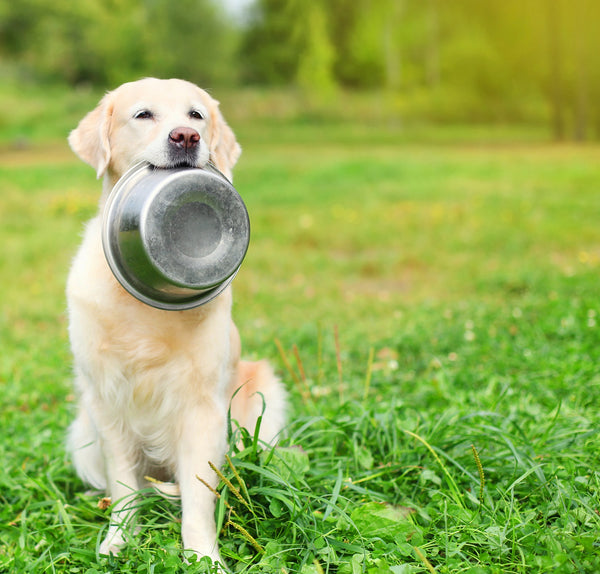
How Much Food Should You Feed a Dog?
As a veterinarian, in my years of practice, I have seen many chubby, if not obese, dogs. Typically, when I bring it up to the owners, their responses usually varied from
“But he barely eats!”
“I like him more a little chubby! Look how cute he looks!”
to
“Yes, I know, but he is fine!”
Although chubbiness can look sweet and cute sometimes, it doesn’t mean that the dog is healthy.
Perhaps your pooch seems perfectly fine to you, you never really never know what health conditions might lay underneath the overall appearance.
In short, diet and nutrition are key components in keeping our dogs healthy and happy. And the biggest factor pet owners can control is the amount of food to serve their pups each day.
Before talking about how much food should be given to a dog per day, let’s first consider the factors that influence the food intake.
Which factors influence food intake?
Feeding a pet seems relatively simple - we open the dog food bag or can, we put the food in the bowl, and that's it! Yet we, as pet owners, need to consider certain factors that can influence our feeding habits.
The right amount of food depends on several factors:
- Age
- Breed
- Size
- Activity level
- Health status
- Portion size
- Even the quality of the food itself
Age
The number of meals per day should be determined by age. For example, puppies will have more meals per day than an adult dog.
Breed and size
The amount of food will be determined by the breed or size of the animal. For example, a large breed will eat more than a small or medium one.
Activity level
This is a very important aspect because the activity level will have a direct impact on the amount of food that should be given in a day. For example, a slower pace dog will eat less than an active dog, even if they are the same size.
Food quality
The quality of food itself directly affects the amount of food given. Poor quality food does not contain the necessary nutrients per serving such as premium food. Therefore, the dog will eat more to assimilate those valuable nutrients in its body. Low quality foods contain a lot of filling ingredients that the dog cannot digest, which will make it defecate more often.
Health status
Dogs with health problems will need a proper and personal diet given by a veterinarian.
Portion size
This is considered an important factor with a direct impact, and it depends on breed, age, and health condition. For example, an obese dog will be fed less food than a fit dog, even if they are the same breed or the same age.

Feeding rules
Because there are currently hundreds of diets for dogs that vary greatly in terms of nutritional value, it is difficult to say exactly how much food a dog should eat in a day. But, in general, dog food manufacturers print on the product label the quantity that should be given per day or per serving. This quantity is not set in stone. It can be adjusted according to the needs of the dog. For example, if a dog is skinny, and the owner wants it to gain extra weight, that quantity can be slightly increased, and vice versa.
Unlike cats (which can eat up to 10 times per day), adult dogs need to have 2 meals per day at an exact time. It is important to keep a schedule in a dog’s feeding routine because they are creatures of habit.
Another tip: if your pup has finished eating, remove any uneaten food. Food should not be left more than 10-15 minutes after they finished eating because they could graze continuously all day if given the opportunity. Grazing presents problems with healthy nutrition, weight control, and even behavior routines.
Puppies, on the other hand, will be fed differently according to their age and size, as follows:
- Puppies between 6-12 weeks old should be fed 3 to 6 times per day with a diet specially formulated for puppies. Occasionally, I find a pet owner prefers to feed their pup simply because for some reason, adult food is sometimes less expensive. However, adult dog food doesn’t have all the necessary nutrients in the right proportions, therefore, feeding a puppy with adult dog food may lead to serious health conditions such as musculoskeletal disorders (rickets), nutritional disorders (hypovitaminosis and avitaminosis), etc.
Small breeds (due to their active metabolism) should be fed 4 to 6 meals per day; medium breeds – 3 meals per day; large breeds – 3-4 meals per day.
- Puppies between 3-6 months old should be fed 3 or 4 meals per day according to their breed and overall health condition. For example, if a puppy is still a little too skinny for its age, veterinarians usually recommend feeding it 4 meals per day until it achieves the desired weight.
- 6 to 12 month old puppies – The puppy is bigger now and two meals per day are usually enough. Also, at this age, many owners will choose to spay or neuter their puppy, and with it, they will have to change their puppy diet to an adult maintenance diet.
- Over 1 year old – At this age, the puppy will be considered an adult (adolescent), and will eat two meals per day.

A Formula for Feeding
If you really want to get into the details of how veterinarians determine your pup’s feeding amount, there’s a scientific formula we are taught to apply. It takes into consideration the fact that the calories it consumes will give your dog the energy needed to perform essential functions of the body, such as digestion, respiration, heart functions, brain functions, etc.
The formula is called "Resting Energy Requirements" (RER). With this formula, it can be calculated how many calories a dog needs daily (to perform the essential functions). Keep in mind that this is a generic formula that is best suited for medium-sized dogs, and was created to meet its general needs.
Dog weight in kg x 30 +70 = daily calories
For small (less than 2 kg) or large breeds (over 45 kg) the RER formula will be:
70 x (dog weight in kg)^0.75 (1).
* To convert to kilograms divide the dog’s weight in pounds by 2.2.
If you want a dog to lose or gain weight, then the RER formula will be adjusted as follows:
(ideal or target weight in kg ^0.75) x 70, where 'ideal or target weight' is the weight that the dog should have for its age, breed, and size (2).
The corresponding factors used to estimate the daily energy needs for dogs are as follows:
|
Neutered adult |
=1.6 x RER |
|
Intact adult |
=1.8 x RER |
|
Inactive/obese prone |
=1.2-1.4 x RER |
|
Weight loss |
=1.0 x RER for ideal weight |
|
Weight gain |
=1.2-1.8 x RER for ideal weight |
|
Active, working dogs |
=2.0-5.0 x RER |
|
Puppy 0-4 months |
=3.0 x RER |
|
Puppy 4 months to adult |
= 2.0 x RER |
Even if we take into account the factors that influence food intake, it is impossible to determine mathematically exactly how many calories a dog should consume per day. This number (RER) must be adjusted according to the general condition of the body, animal welfare, age, etc. In other words, calorie tables cannot take into account what could make an animal's situation unique (overall appearance, health status, age, etc.).
A few extra pounds/kilograms above the ideal weight can endanger the dog's health. Unfortunately, when a dog is diagnosed as obese or overweight, it is clear that there are already secondary health problems.
Health problems that are affected by weight can include osteoarthritis, lung and heart problems, kidney disease, type 2 diabetes, various forms of cancer (especially with intra-abdominal localization), etc. All these problems will affect the dog’s well-being and shorten its life.
The Amount of Food Given to Adult Dogs
The amount of food offered to adult dogs will depend very much on their health. Some adult dogs are healthy and active, while others are lazy or have health problems, such as heart problems, kidney problems, suffer from obesity or diabetes.
Healthy adult dogs need more protein than a normal adult dog to maintain their musculoskeletal system healthy. Dogs that have different health problems need special supplements or a proper and personal diet. There are special types of food for adult dogs, but also food specially designed for different types of diseases.
The Amount of Food for Overweight or Obese Dogs
Did you know that obesity is one of the top diseases in pet dogs in America? The factors that contribute to this disease are divided into 3 categories: genetic predisposition, reproductive management, and dietary/physical management (3).
Deciding how much food to give your overweight dog can be a challenge because it’s tough for most pet owners to know they’re limiting the amount of food their fur-babies can eat.
The portion size for an overweight dog can be adjusted according to the amount of food listed on the label for the ideal weight. For example, if a 25 kilogram dog is considered obese (according to its breed and size), and its ideal weight is 20 kg, then it will be fed with the indicated amount (on the dog food bag) for the ideal weight for the respective breed and size until the dog achieves the desired weight.
Just keep in mind, an obese dog is not a happy dog, so it is very important that we help our pooches stay in shape!
Healthy Pets are the Heart of Spring Naturals Meals
Pets today face the highest ever rates of pet obesity, diabetes and heart disease because of highly processed, mass-produced pet food.
That’s why at Spring Naturals, we only use real meat and never any fillers. Our foods are grain free or as low carbohydrate as possible. Just like for humans, a healthy protein, low-carb diet is optimal for a long and healthy pet life. Spring Naturals is the original high-protein kibble to be certified low glycemic.
Browse our selection of healthy pet meals at www.SpringNaturals.com
Dr. Iuliana Mihai, DVM, Masters In Small Animals And Equines Pathology
Iuliana graduated from the University of Agronomical Sciences and Veterinary Medicine in 2012, Romania. She has a Master’s degree in Small Animal and Equines Pathology and a strong affinity for Veterinary Parasitology and Laboratory. In 2013 she started her Ph.D. in epithelial cancer in dogs and cats. She volunteered at the faculty’s clinic at her 3rd year of study, and continued her career in small animal p athology and laboratory. She has one cat and eleven rats. Her interests outside of work include traveling, writing, and crafting.
References
- https://www.dvm360.com/view/calculate-perfect-portions-pets
- https://petobesityprevention.org/weight-loss-dogs
- Bland, I. M., Guthrie-Jones, A., Taylor, R. D., & Hill, J. (2009). Dog obesity: owner attitudes and behaviour. Preventive veterinary medicine, 92(4), 333-340.

Post a Comment!